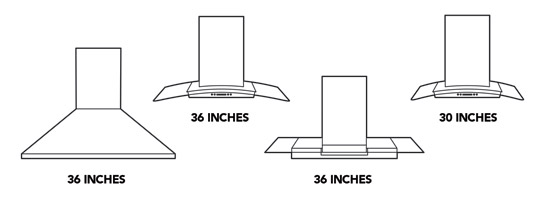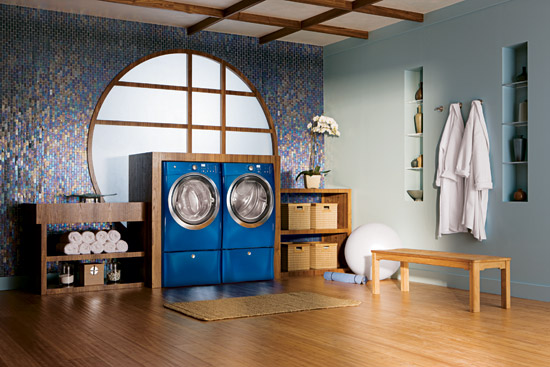Using Built-in Appliances to Enhance Design
Dishwashing Appliances
Built-in dishwashers are generally very standardized in terms of size and function for American kitchens. Allowing for their under-counter installation next to the primary sink in the kitchen is the most common and effective way to have them built in and support the dishwashing functions of the kitchen. This suggests that dish storage is located nearby as well which speaks to locating the sink/dishwasher in a central location in the kitchen.
The biggest differences between different dishwashers come from overall energy use and hot water use as drivers in dishwasher performance. A significant portion of the energy used by dishwashers is actually the energy required for heating the water they consume, since almost all dishwashers use internal booster heaters. That is actually a good thing, because it allows domestic hot water heater temperatures to be turned down to around 120 degrees, instead of the higher temperatures usually desired for dishwashing. The lower water heater temperatures mean less energy is used on an ongoing basis while the higher temperature is created only for the intermittent needs of the dishwasher. When selecting dishwashers, consider the following:
• Water usage. Specify a unit that requires less water overall and more options on controlling the water used. Many newer models have been documented to actually use half the water that conventional hand washing would require. Further, hand rinsing dishes can use up to 20 gallons of water before the dishes are even loaded.
• Rinse option. For times when dirty dishes sit overnight, a dishwasher with a rinse feature will typically use a fraction of the water needed to hand rinse.
• Load size. Dishwashers use about the same amount of energy and water regardless of the number of dishes inside, so sizing the unit to promote running full loads whenever possible will be appropriate.
• Drying. Specify units that have a no-heat drying option. This typically gives good drying results with less energy.
• Soil sensors. An additional significant specification detail is to call for a dishwasher that incorporates soil-sensors, since they adjust water use depending on how dirty the dishes are in each load. Recent improvements in test procedures better estimate the energy consumption of soil-sensing dishwasher models, allowing more accurate comparisons between models.
• Food disposing. Dishwashers for residential use fall into two basic categories—food-disposing where particles are drained with the rinse water and non-food disposing models where particles are collected in a strainer that must be emptied and rinsed manually. Machines in both categories may or may not have a filter, which generally comes in two types—coarse or fine. With coarse filters, food particles stay in suspension and can be re-deposited onto dishes after washing. As a result, a larger amount of rinse water is typically needed than in fine filtered models. Fine filter models generally have less food re-deposited, as most particles are filtered out prior to re-circulation in the wash cycle. Approximately half of the dishwashers sold are fine-filtered models and half have coarse filters or none at all.
Ventilation Hoods
In addition to providing a useful function over gas fueled cooking appliances, ventilation hoods serve some other purposes as well. First they help eliminate any smoke, excess heat, or cooking odors that may result from cooking. This presumes of course that they are in fact ventilating to the outdoors and are not simply re-circulating the air that passes through them. This function is performed whether the hood is wall mounted or isolated over an island up to ceiling outlet.
Beyond the functional performance of ventilation hoods, they can also create a strong visual statement since they are decidedly vertical element in what may otherwise be a series of horizontal lines and surfaces. Therefore selecting a ventilation hood with exposed ductwork in a finish that is complementary to the rest of the kitchen, such as stainless steel, can reinforce the cooking area a visual focal point. Since these units come with built-in lighting as well, they can contribute to the overall lighting scheme and balance the functional lighting needs in the kitchen with the visual ones.
 |
Ventilation hoods come in a variety of design enhancing shapes in sizes to match the cooking appliances that they serve. Image courtesy of Electrolux |
Laundry Area Creativity
New laundry equipment as discussed earlier can be located in a convenient laundry room to accommodate multiple functions or be integrated into clothes hanging or dressing areas. In either case, there are choices in how the washer and dryer appliances are arranged—either horizontally on the floor adjacent to each other in some fashion or vertically stacked on top of each other. When considering the layout, differences in the appliances will make a difference on the successful layout and function of any laundry area.
The first choice in laundry appliances is whether to use front-loading or top-loading appliances. Conventionally, residential washers have been top-loading while dryers have been front-loading although there has been a recent trend to use front-loading machines for both. These appliances operate by spinning on a horizontal-axis (hence the front-loading) and are generally much more efficient than conventional vertical-axis (top-loading) models. In washing machines this is attributed in large part to the fact that top-loading machines with agitators need to fill the tub completely with water while the horizontal axis machines do not. Hot water heating accounts for about 90 percent of the energy consumed by a clothes washer—only about 10 percent goes to the electricity to run the washer motor. Hence, specifications for washers should clearly address both energy and hot water usage. If water efficiency is a particular concern, note that washers are rated with a Water Factor (WF) that indicates the number of gallons needed for each cubic foot of laundry. The lower the WF, the less water needed to operate.
 |
Front-loading or horizontal-axis washers and dryers are generally found to be more energy efficient than top-loading models. Photo courtesy of Electrolux |
When it comes to clothes dryers, the fundamental choice is between electric and gas-fired models. In terms of comparative energy use, gas dryers are generally less expensive to operate. However, most sources agree that there is not a lot of variation in overall energy actually used between models. Typically, it is usage and running time that dictate the amount of energy used. Therefore, controls for turning off dryers become the major consideration for energy consumption, particularly if coupled with an efficient washer that has extracted a lot of the water out of the clothes already. The fundamental controls choice is whether or not the dryer uses sensors to automatically turn off the dryer once clothes are dry. The alternative is timed drying, leaving the running time, and corresponding energy use, to the guesswork of the user. The best dryers have moisture sensors inside the drum for sensing dryness and turning off the machine. Most others only infer dryness by using temperature sensors in the exhaust air portion of the dryer, which may result in running the dryer longer than needed. Compared with timed drying, savings of about 10 percent with temperature-sensing controls and 15 percent with moisture-sensing controls are possible.









